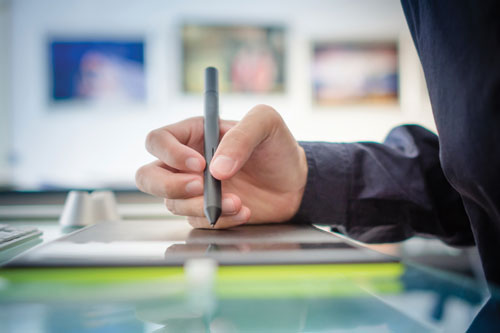Technology affects day-to-day living, including the workplace. Playing a vital role in the advancement of various workplaces, technology also has its limitations. Hear from four Cairn University professors on how technology has changed the way that they relate to their work in business, art, education, and music.
Business & Technology
Technology has always shaped business. The landscape of an industry changes forever with every innovation that gives one person or company a competitive advantage over another. Some technologies, such as the invention of the “horseless carriage” at the beginning of the 20th century, create entirely new industries. Others, like the silicon transistor, reshape existing industries.
However, one of the largest impacts of technology in business, regardless of industry, affects how employees in businesses actually work. During the height of manufacturing in America, the factory whistle dictated the beginning and ending of the workday. Workers took pride in a well-made product and, when the day was done, gave little thought to the workplace.
Today, however, the boundary between personal life and the workday is increasingly blurred. At the same time, the amount of time people actually spend working each year has led some communities, even entire nations, to pass legislation limiting overtime and remote access to company email outside of normal office hours.
The rise of Cyber Monday exemplifies the encroachment of personal technology use into corporate time. While employees began using corporate internet connections for non-business use when the speed of corporate networks surpassed slow dial-up connections at home, modern broadband and mobile connectivity have not caused any noticeable decrease in this common workplace habit, according to a 2016 survey led by Robert Half Technology.
On the Monday and Tuesday following Thanksgiving 2016, more online sales were made from desktop computers than mobile phones, according to data from comScore. According to similar data from Adobe, desktop computers were used for 69% of all online Christmas shopping purchases, despite mobile devices accounting for nearly half of all traffic.
Conversely, the ubiquity of smartphones has led many supervisors and employees to feel obligated to always be available to respond to work-related issues, especially when the company is supplying the device. The effect this pressure has on work-life balance differs from person to person. For some, the ability to complete tasks and resolve potential problems while away from the office leads to increased engagement and higher overall satisfaction. For others, the idea of being always on call leads to greater stress.
This shift has led to conflict between management and workers. The ultimate manifestation of this geographic flexibility is telecommuting. This shift has also led to debates over telecommuting. Nowadays, many workers can complete all their responsibilities without ever stepping into a company office, offering workers unprecedented flexibility. According to several studies, telecommuting employees generally experience improved overall personal happiness, attributed to increased productivity, avoidance of commuting stress, and additional personal time gained from not having to commute. Even among those who only telecommute for part of their workweek, increased flexibility is one of the most sought-after non-financial benefits. For many companies, the real costs associated with supporting telecommuters are lower than those of maintaining a traditional office.
Despite its popularity among workers, the practice of telecommuting is not universally popular among employers. Upon assuming leadership of Yahoo! in 2012, Marissa Mayer informed remote workers that they would have to either come to the office or find other work. In early 2017, IBM made a similar announcement to its marketing team. Both companies expressed hope that the change would lead to better teamwork. Neither announcement was well-received by staff. While there is some evidence that teams communicate better when they are physically together, modern teleconferencing tools and the pervasiveness of mobile computing have removed strong reasons to require workers to congregate in one space. Furthermore, increased international competition drives organizations to bring together the best people they can find regardless of location. The need to foster collaboration and communication among global teams has never been greater.
Michael Sabal—Assistant Professor of Computer Science and Information Systems
Art & Technology
Once, I was invited by a friend to watch a blacksmith at work. Over a small propane burner, he heated a metal shoe and meticulously hammered it into a shape that conformed to the horse’s hoof. While chatting, he found out that we were artists and proudly regaled us with a story of drawing Mickey Mouse on his daughter’s bedroom wall. The blacksmith made sure to let us know that he didn’t “cheat” by projecting the image, but drew it all by hand in large proportion.
 Bring up technology in conversations with artists, and you may find just another way of dividing the world into two groups of people: those who embrace technology and those who hold it at arm’s length. In the fine arts world, technology often carries a stigma; many believe “the old way is the good way.” I’ve known artists to hide their resource photos before anyone steps into the studio or to minimize the screen of their laptops when working through possible color variations. Taboo aside, how has technology changed the profession of the artist?
Bring up technology in conversations with artists, and you may find just another way of dividing the world into two groups of people: those who embrace technology and those who hold it at arm’s length. In the fine arts world, technology often carries a stigma; many believe “the old way is the good way.” I’ve known artists to hide their resource photos before anyone steps into the studio or to minimize the screen of their laptops when working through possible color variations. Taboo aside, how has technology changed the profession of the artist?
If I were to mention one thing, it is the experience of immediacy. The notion of “immediacy” traditionally refers to a romance with the media: the feedback from the connective drag of the pencil on textured paper or the viscosity of paint as it is mixed with pallet knife. Sensitivity to the tactile guides the motion and response of the artist.
Some might argue that with technology there is a different type of immediacy. The ability to create an image has been parceled out to everyone with a photo app. Pressing a button makes an image instantly “artistic.” The formerly tactile way of developing the visual is condensed into a preset filter selection. You’ve seen it on book covers when someone throws a filter on a photo and considers it “artsy.”
I understand these concerns: If everyone has the ability to make the mediocre look pro at the touch of the button, what then is the role of the artist?
The role of the artist continues to be the one who climbs over the mainstream and pushes for profound means of expression that stand apart from the chatter of the ubiquitous.
Technology’s immediacy of time actually supports the role of the artist by enhancing the artistic process. “Process” is the way the artist generates ideas and puts art-making into practice and habit. Although technology may not necessarily save time, it can maximize potential. Technology is the new sketchbook. Ideas can be tried out, manipulated, and realized. Mistakes happen but can disappear as alterations of imagery are investigated and developed.
As an instructor using technology, I’m not facing the issue of what we are capable of doing, but how to teach today’s students to think in the creativity of the immediate. Technology hasn’t quite achieved that romantic gloss of immediate materials in the old way, but it has fundamental perks of immediate feedback in process and encourages new forms of expression.
While the blacksmith-turned-mural artist had a respectable notion of discipline and purity, I kept thinking that if Michelangelo had a projector, I’m pretty sure he would have used it on the Sistine Chapel. He still would have had to come up with the content and composition, consider the balance of color, and implement the new art style of perspective that included complicated visual elements like foreshortening. Technology would not have encumbered his ability to distinguish himself—it may have even enhanced it.
Matthew Stemler—Instructor of Graphic Design and Studio Art
Education & Technology
I am a teacher, and I have been for over twenty years. But before I was a teacher, I was a student.
As I fondly recall many teachers from those years, there is one who stands out from all of the rest: Mr. Green. He was my fourth-grade teacher, tall and energetic, and he brought fun into the classroom. I remember that he would play games with math, and he would throw chocolate rewards to those who worked well. I worked for chocolate, and I wasn’t ashamed of it. But as I consider today’s classroom, I often wonder how Mr. Green would have kept up with the changes.
Consider the following scenario: The teacher waits behind her desk, eyeing students as they traipse in. Each student carries a cell phone. While walking in, students are texting friends. While students wait for class to start, they are using Snapchat. During class, even with firm rules in place, teachers struggle daily with how to pry students’ fingers from devices of all sizes.
Today, not only do teachers have to help unravel the mystery of algebra, but we must consider how to help guide students through the possibilities and pitfalls of technology. Students’ ubiquitous use of technology extends beyond the classroom. According to a 2015 study by Common Sense Media, the average teenager spends an average of nine hours a day with screens. “Tweens” (8–12 years of age) average six hours a day.
The study raises questions about the correlation between increased screen time and youth’s social and emotional well-being, physical activity, and homework. Many parents and teachers alike anxiously wring their hands, lamenting over how times have changed. Instead of passively worrying over the changes in our students’ habits, teachers have an opportunity before us. We have the chance to teach stewardship to these tech-savvy youth. As students spend more of their time hunched over devices, teachers can step in to help them make their time on technology more fruitful and God-honoring.
Students need a guide as they decide which apps to use. They need help reflecting on how they spend their time. They need help forming healthy habits. Although technology develops faster than teachers can learn the latest gadgets and apps, teachers can still stand in the ga p, leading students to a healthier place.
p, leading students to a healthier place.
In addition to teaching math or reading or social studies, teachers forge meaningful and lasting relationships with students, the kind that authentically influence their lives. We are in a unique position to mentor students, helping them use technology in better and more intentional ways, avoiding or eliminating unhealthy habits.
Students need not only direct instruction in how to better use screen time; they also need to see healthy habits in action, observing first-hand how to keep technology addictions under control. Teachers serve as models, positioning them to demonstrate productive behavior by using technology in thoughtful and responsible ways inside the classroom.
While Mr. Green never had to think about technology in his classroom, I like to think that he would have found meaningful and fun ways to help us in our daily use of technology. He was the sort of teacher who would have helped us critically examine how we spend our time on devices, and he would have modeled what it looks like to have a good relationship with technology.
What’s more, he would have found a way to reward us for our efforts with chocolate.
Barbara Cooper—Part-time Faculty, Special Education
Technology & Music
Technology has long influenced the way we listen to, create, and teach music. Examples include innovations such as the lined staff (circa 11th century), Gutenberg’s movable type printing press (mid-15th century), and Thomas Edison’s phonograph (late 19th century). More recent advances continue to expand the possibilities for the way we make and consume music. Key developments, such as the following, tell the story of technology making music and music creation more accessible.
Music synthesis (1960s-1980s) Synthesis is the electronic fabrication of instrument sounds. Electronic music pioneers like inventor Bob Moog and Stanford University professor John Chowning brought music synthesis to the masses. For instance, Chowning developed FM synthesis—a cheaper, more efficient way to synthesize sounds—bringing the cost of a synth keyboard like the 1983 Yamaha DX7 to less than $2,000, making personal ownership possible for more consumers. Today, consumers can find keyboards with hundreds of different synthesized sounds (such as piano, bass, drums, and strings) for the cost of eating out.
Micro/personal computers (1970s-1980s), especially Apple’s Macintosh (1984) With the appearance of microchips, room-sized computer installations were replaced by personal computers the size of a toaster! Apple wisely marketed the Macintosh computer’s friendly, intuitive operating system to the education market and artists. The development of “killer apps” for musicians, such as those for typesetting and recording music, opened the gate to musical creativity to many more students and amateurs.
 MIDI (early 80s) Normally competitive music instrument manufacturers (such as Yamaha, Korg, and Roland) realized they’d all benefit by standardizing the way their products communicate with personal computers. The result was MIDI (Musical Instrument Digital Interface), which caused an explosion of music software development.
MIDI (early 80s) Normally competitive music instrument manufacturers (such as Yamaha, Korg, and Roland) realized they’d all benefit by standardizing the way their products communicate with personal computers. The result was MIDI (Musical Instrument Digital Interface), which caused an explosion of music software development.
The World Wide Web (1989) and Web 2.0 (early 2000s to present) Millions of users connected via the web can now share, stream, and download music. The second generation of the world wide web, “Web 2.0,” features interactive sites and cloud-based apps such as Facebook, YouTube, Wikipedia, and Google Docs. The careers of hundreds of entrepreneurial musicians have been launched on YouTube, and web apps (such as Noteflight and Soundtrap) are used by millions to write and record music “in the cloud.” Church musicians even download sheet music and tracks for use in worship. In education, Chromebooks—low cost laptops that run cloud-based apps in a browser—are becoming ubiquitous.
GarageBand (2004) Apple had the inspiration to create GarageBand, an entry-level multi-track recording program that would come at no cost on Macintosh computers. Its intuitive, easy-to-use interface contributed to an explosion of musical creativity in K-12 music education.
iPhone (2007), iPad (2010), and mobile apps The Pew Research Center report “Teens and Technology 2013” revealed that about three-fourths of all teens “access the internet on cell phones, tablets, and other mobile devices.” Roughly three-quarters of Americans own smartphones, which allow us to store and play thousands of songs. Many mobile apps facilitate creating and performing music, including easy-to-use virtual instruments and music looping apps. These apps are especially popular with special learners and students without formal musical training. These developments have certainly influenced the 21st century music world. In the private sector, synthesized instruments and digital recording have led to new jobs—such as creating ringtones and scoring video games—but they’ve also contributed to a downturn in work for live musicians. In education, teachers use these amazing tools to facilitate creativity and collaboration, student-centered inquiry, and project-based learning. But the big story is more people interacting with music!
Scott Watson—Adjunct Professor, School of Music